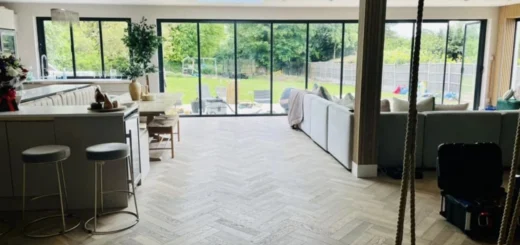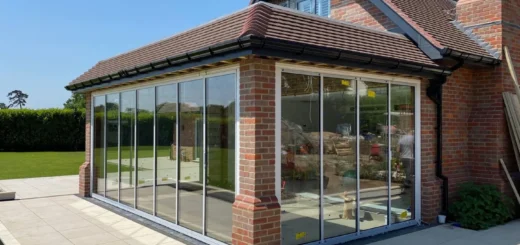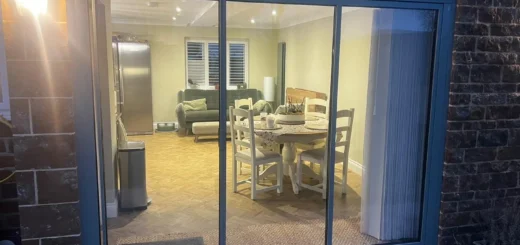Slimline Internal Bifold Doors: Everything You Need to Know
Table of Contents
History and Function of Slimline Internal Bifold Doors
Development of Bifold Doors
The concept of bifold doors (also known as concertina doors or folding doors) dates back centuries, with early versions appearing in barns and stables. These rustic forerunners bore little resemblance to today’s sleek designs. In the 1950s and 60s, bifold doors gained popularity in homes, often made from hollow-core wood panels. Bulky and prone to sticking, they were functional but far from stylish.
As manufacturing techniques advanced, so did bifold door design. The 1980s saw the introduction of slimmer profiles and improved hardware. Modern slimline internal bifold doors feature narrow frames and large glass panels, offering a striking balance of form and function.
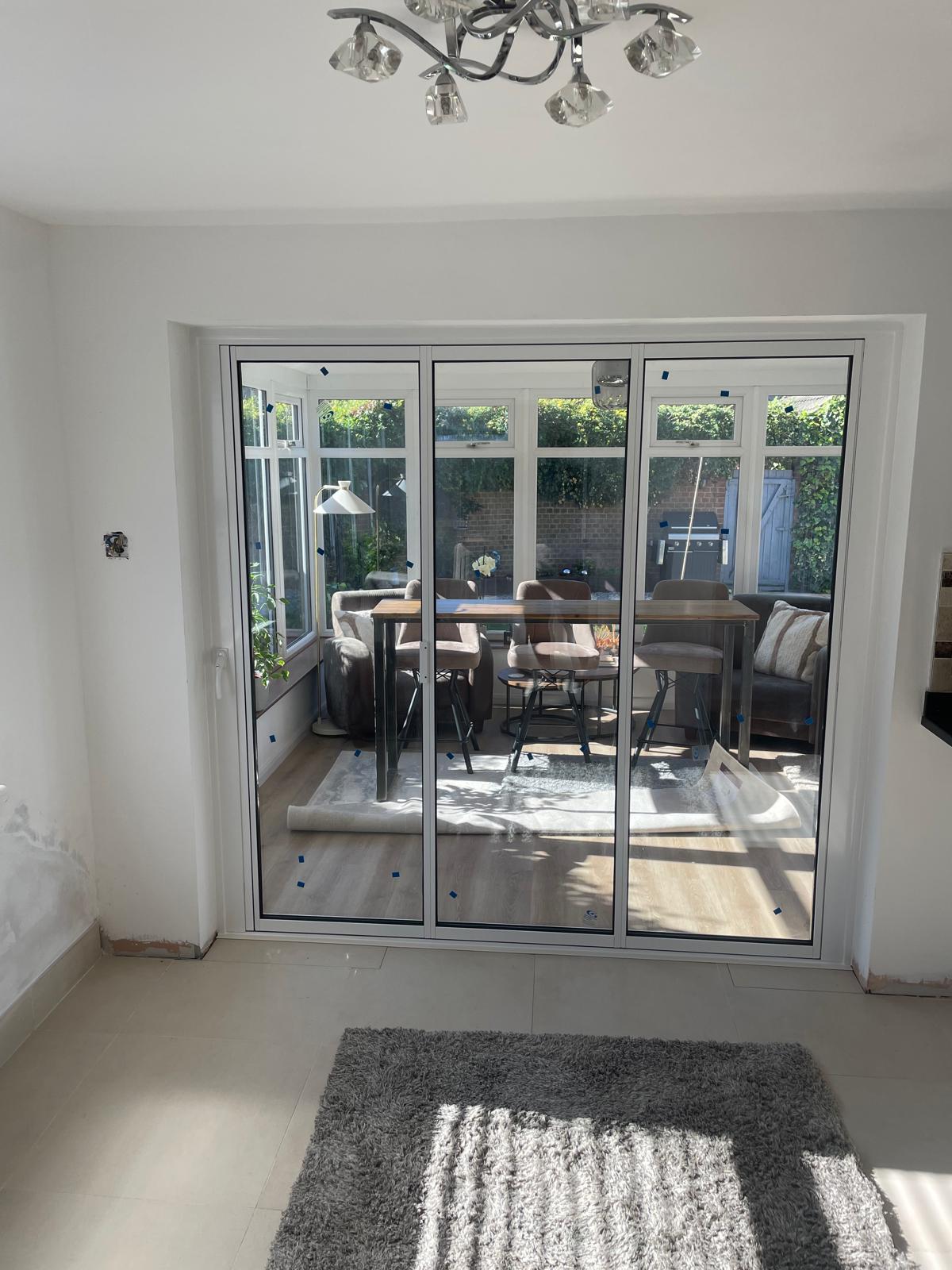
How Internal Bifold Doors Operate
Slimline internal folding doors work on a simple yet clever principle. Connected panels fold together like a concertina, gliding along a track. This ingenious system allows for smooth opening and closing, even in tight spaces. Unlike traditional swing doors, they don’t need a large arc of clearance.
Most internal bifolding doors feature two to six panels, depending on the opening width. For average-sized doorways, a two or three-panel configuration often suffices. Larger openings might call for more panels, creating a dramatic effect when fully opened.
A top-hung design is common on slimline systems, this places the weight on the upper track, ensuring effortless operation. A discreet bottom guide keeps the panels aligned without obstructing the threshold.
Defining Slimline
The term “slimline” in the context of bifold doors refers to their narrow frame profiles. This design philosophy prioritises a large glass area with very little visible framing. The result? Doors that seem to disappear when open and offer unobstructed views when closed.
Compared to standard bifolds, slimline versions boast frame widths that can be up to 50% narrower. This reduction makes a noticeable difference in both aesthetics and practicality. Slimmer frames mean more light, clearer sightlines, and a more contemporary look.
Measuring Slimline Profiles
To truly appreciate the slimline difference, it’s worth looking at the numbers. Standard bifold door frames might measure 100mm or more in width. In contrast, slimline internal bifold doors often feature profiles as narrow as 40mm.
Slimline Internal Bifold Door Terminology
Frame Profiles and Sightlines
You’ll often hear terms like “profiles” and “sightlines”. These words describe key aspects of the door’s design and appearance. Profiles refer to the cross-section of the door frame, while sightlines indicate the visible frame width when the door is closed.
Slim profiles are a defining feature of modern bifold door designs. These narrow frames allow for larger glass panels, letting more light into your space. The reduced frame size doesn’t compromise strength or stability. Advanced materials and engineering ensure that slim frames maintain their structural integrity.
Sightlines have a large effect on the overall look of bi-fold doors. Slimmer sightlines mean less visible frame and more glass when the doors are shut. This creates a cleaner, more open feel in any room. Some high-end slimline internal folding doors boast sightlines as narrow as 35mm, barely noticeable when installed.
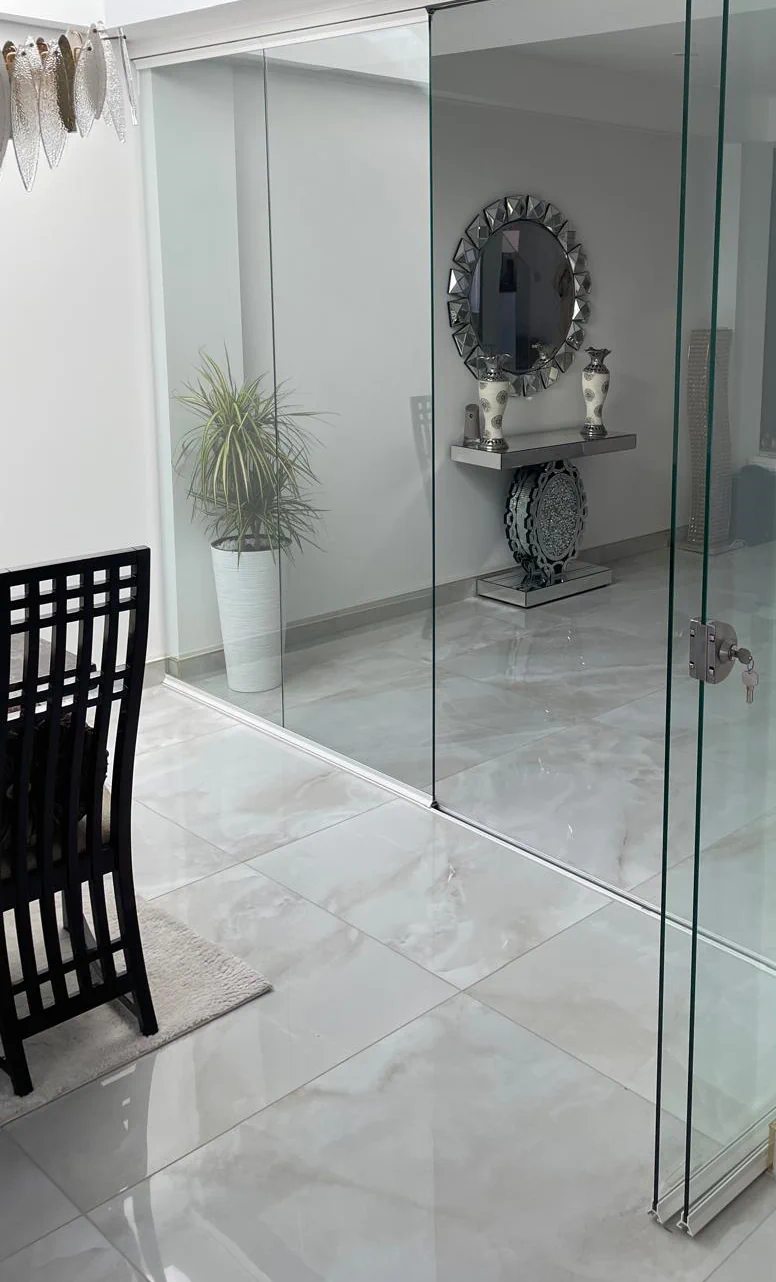
Frameless Slimline Internal Bifold Doors
For those seeking the ultimate in minimal design, frameless slimline internal bifold doors offer a striking solution. These doors use thick, tempered glass panels with minimal hardware, creating an almost invisible barrier when closed. The effect is stunning, especially in modern interiors or as glass office partitions.
Frameless designs push the boundaries of what’s possible with internal slimline folding doors by eliminating visible frames altogether and creating a sense of openness. This style is particularly effective in smaller spaces, where traditional doors might feel imposing or restrictive.
While frameless doors offer unparalleled aesthetics, they do have downsides: the weight of the glass panels demands robust hardware and precise installation, the cost is often higher, and they typically have poorer thermal performance and weather resistance (although the latter is usually not a concern with internal doors).
Despite their delicate appearance, these doors are surprisingly sturdy and can withstand regular use in both residential and commercial buildings.
Incorporating Slimline Internal Bifold Doors in Home Design
Sizing and Space Requirements
When planning to install slimline internal bifold doors, accurate measurements are key. These doors come in various widths, typically ranging from 1.8m to 4.8m for internal use. The number of panels you’ll need depends on the opening size and your preferred fold configuration.
For smaller openings, bi-fold internal doors with two or three panels often suffice. Larger spaces might require four or more panels to span the width effectively. It’s worth noting that odd numbers of panels allow for a traffic door, which can be opened independently for quick access.
Made to measure internal bifold doors offer the best fit for your space and can be customised to fit non-standard opening sizes. They ensure smooth operation and eliminate gaps that could compromise privacy or energy efficiency. When measuring, don’t forget to account for the stacked width of the doors when fully open. This ‘parking space’ is usually about 10-15% of the total door width.
Matching Interior Styles
Slimline internal bifold doors adapt well to various design aesthetics. In modern minimalist homes, their clean lines and large glass panels complement the uncluttered look. For traditional interiors, choose frames with period-appropriate details and hardware to maintain cohesion with your existing decor.
These doors excel at creating flexible living spaces. In open-plan areas, they can temporarily divide rooms for privacy or noise control. When opened, they allow for free-flowing movement between spaces, ideal for entertaining or family living.
Bifold conservatory doors offer a stylish way to separate your conservatory from the main living area. During colder months, you can close them to retain heat while still enjoying the view. In summer, open them fully when desired.
While white remains a popular choice for its flexibility, bold colours can make a statement. Black frames, for instance, can add a contemporary edge to both modern and traditional spaces. Powder-coated grey aluminium bifold doors are also very popular currently, in various shades (such as anthracite grey).
Unconventional Uses
Think beyond standard room dividers when thinking about getting slimline internal folding doors. They can serve as innovative solutions in various parts of your home. In home offices, these doors create a professional workspace that can be easily closed off at the end of the day.
For walk-in wardrobes or pantries, internal bi-fold doors provide full access when open and a neat, space-saving closure when not in use. Their slim profile ensures they don’t dominate the room, even in smaller spaces.
Bringing Light to Dark Spaces
Slimline internal bifold doors can help brighten darker areas of your home. By replacing solid walls with these glass doors, you allow natural light to flow between rooms. This can be particularly effective in north-facing rooms or in properties with limited windows.
Selecting Slimline Internal Bifold Doors
Frame Materials
The choice of frame material for slimline internal bifold doors affects both their appearance and performance. Aluminium bifold doors are a popular option due to their strength and slim profiles. These frames can support large glass panels while maintaining slim sightlines, making them ideal for modern interiors.
Timber frames offer a classic look and work well in traditional homes. They provide warmth and character but may require more maintenance than other materials. For a balance between aesthetics and practicality, composite frames combine the best of both worlds. They offer the look of wood with the durability of synthetic materials.
When choosing a frame material, think about the overall style of your home. Slimline bi fold doors should complement your existing decor rather than clash with it. Remember that the frame colour and finish can have a big impact on the final look.
Hardware and Operational Components
The smooth operation of slimline internal bifold doors depends largely on their hardware. High-quality running gear ensures that the doors glide effortlessly along the track. Look for systems with adjustable rollers, which allow for fine-tuning even after installation.
Handles and locks are both functional and decorative elements. Choose designs that match your interior style while providing secure closure. Some systems offer flush handles that sit within the frame, maintaining the sleek lines of your slimline doors.
The tracking system is another important component. Top-hung tracks are often preferred for internal doors as they don’t require a bottom track, creating a step free floor threshold. However, bottom-rolling systems can be a good choice for heavier doors or in situations where the ceiling can’t support the full weight.
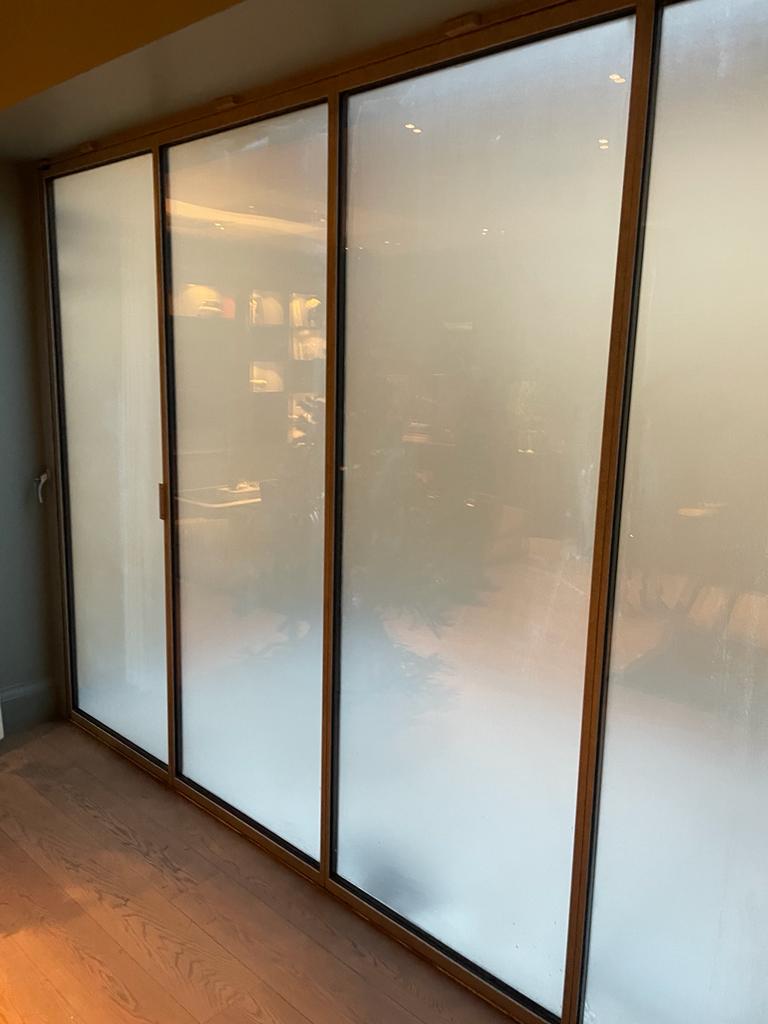
Glass Options
The type of glass you choose affects not only the look but also the performance of your doors. Clear glass results in the most light transmission and visibility, ideal for creating an open feel between rooms.
For areas where privacy is needed, frosted or patterned glass offers a solution. These options allow light to pass through while obscuring the view. Some manufacturers offer switchable glass, which can change from clear to opaque at the flick of a switch.
Single glazed doors are often sufficient for internal use, as thermal insulation is less of a concern than with exterior doors. However, double glazed options are available if you want to improve sound insulation between rooms. This can be particularly useful for home offices or music rooms.
Safety and Security
When selecting glass for your slimline internal bifold doors, safety should be a top priority. Toughened safety glass is designed to break into small, dull-edged pieces if shattered, reducing the risk of injury. Laminated glass offers an extra layer of security, as it holds together when broken. These safety features are especially important in busy households or areas with children. Security is often less important in internal doors compared to external patio doors, but it can still be a factor – for example when connecting the main part of a home to a less-secure area like a conservatory or garage.
Alternatives to Slimline Internal Bifold Doors
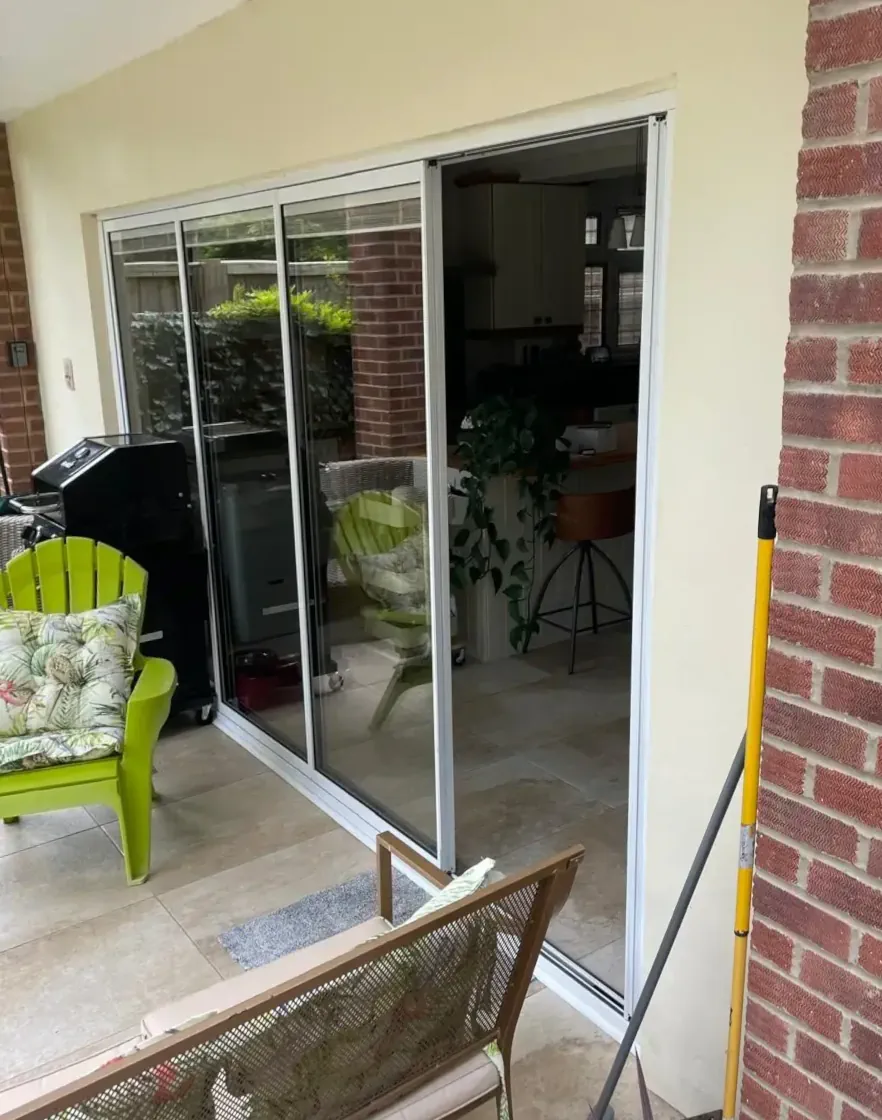
Slide and Turn Door Systems
While slimline internal bifold doors offer many advantages, they’re not the only option for creating flexible living spaces. Slide and pivot doors (also known as slide and turn or slide and stack) provide an alternative worth exploring. These doors operate by sliding along a track and then pivoting to stack neatly against a wall.
In homes with limited space, slide and turn doors can be particularly useful. Unlike bifold doors, which require space to fold, slide and turn systems need only a small area for the panels to pivot. This makes them ideal for tight corners or narrow openings where every centimetre counts.
Slimline bi fold doors and slide and turn systems share many benefits. Both offer large glass areas and the ability to open up spaces fully. However, slide and turn doors often provide a more uniform look when closed, as the panels sit in line rather than in a zigzag pattern.
Slimline Sliding Doors
For those who prefer a simpler opening mechanism, slimline sliding doors present another option. These doors glide along a single track, bypassing each other to create an opening. They’re particularly effective in situations where you want to maintain a clear view even when the doors are partially open.
Sliding doors excel in rooms where space is at a premium. Unlike slimline internal folding doors, which need clearance to fold, sliding doors only require space parallel to the wall. This makes them a smart choice for smaller rooms or areas with furniture placed close to the doorway.
The slim profiles available in modern sliding door designs rival those of their bifold counterparts. With narrow frames and large glass panels, these doors can create a striking visual effect. They’re particularly suited to contemporary interiors where clean lines and minimalist design are prized.
Choosing the Right Door Style
When deciding between slimline internal bifold doors and other options, think about how you’ll use the space. Bifolds offer the advantage of opening up almost the entire doorway, creating a wide, unobstructed opening. This can be ideal for joining living and dining areas or connecting indoor spaces with a patio or garden.
Slide and turn or sliding systems might be preferable if you often want to keep part of the doorway closed. They allow for more flexible partial openings, which can be useful for controlling airflow or maintaining some separation between spaces while still allowing movement.
For those who love the traditional look, French doors remain a classic choice. While they don’t offer the same wide openings as slimline bi fold doors, they can provide a elegant solution for connecting two rooms. Modern French door designs often feature slimmer frames than their traditional counterparts, aligning more closely with contemporary aesthetics.
Sound Insulation
When choosing between door styles, don’t overlook sound insulation. Slimline internal folding doors, with their multiple seals when closed, can offer good sound blocking properties. However, sliding doors with quality seals and thicker glass can also provide excellent acoustic insulation. Think about your specific needs – a home office might require better sound blocking than a living room-to-dining room connection.
Frequently Asked Questions
What are bifold doors?
Bifold doors, also known as concertina glass doors, are a type of door system that folds open, with panels that slide and stack neatly to one or both sides. They typically consist of two or more connected panels that fold in pairs, allowing for a wide opening when fully retracted. These doors are popular for both interior and exterior use, offering a flexible way to connect spaces or bring the outdoors in.
Can slimline internal bifold doors be automated?
While automation is more common in external bifold doors, some slimline internal bifold doors can be automated. This usually involves installing an electric motor and control system. Automated internal bifolds can be particularly useful for those with mobility issues or in high-traffic areas where hands-free operation is beneficial. However, the cost and complexity of automation mean it’s less frequently chosen for internal doors.
What types of glass can be used in internal bifold doors?
Internal bifold doors with glass offer various options to suit different needs and preferences. Clear tempered glass is a popular choice for good light flow and creating an open feel. For privacy, frosted or obscured glass options are available. Decorative glass, such as etched or patterned designs, can add visual interest.
Laminated safety glass is often used in high-traffic areas or homes with children for added security. Some manufacturers also offer speciality glasses like low-iron glass for improved clarity or acoustic glass for better sound insulation.
Can slimline bifold doors be used in commercial settings?
Slimline bifold doors are increasingly popular in commercial settings due to their flexibility and aesthetic appeal. They’re often used in restaurants to create indoor-outdoor dining areas, in offices to divide meeting spaces, or in retail environments to create flexible shop fronts. These doors can help businesses make the most of the available space and create adaptable environments. However, commercial applications may require specific features like specific security measures or fire-rated options, so it’s important to choose doors that meet relevant building regulations and safety standards.
What’s the difference between slimline bifold doors and sliding doors?
While both slimline bifold doors and sliding doors can create large openings, they operate differently. Bifold doors fold and stack to the side, while sliding doors glide along a track, overlapping each other. Bifolds can typically open up more of the aperture, often up to 90%, whereas sliding doors usually open to about 65% of the width. Slimline bifold doors tend to have a more pronounced visual impact when open, creating a striking design feature. Sliding doors, however, don’t require space for the doors to fold back, which can be advantageous in certain layouts.
Are there any disadvantages to slimline bifold doors?
While slimline bifold doors offer many benefits, they do have some potential drawbacks. They typically cost more than standard doors due to their complex mechanism and high-quality materials. The multiple panels and tracks can require more maintenance to ensure smooth operation. In very small spaces, the stacked panels when open might be more intrusive than a single hinged door. The larger glass areas might also lead to increased heat loss compared to solid doors, although modern bifold doors are often built using advanced techniques and materials for higher thermal efficiency.
Are dark or light colours better for slimline internal folding doors?
The choice between dark and light colours for slimline internal folding doors depends on your interior design goals and the specific characteristics of your space. Light colours can make a room feel more spacious and bright, which can be particularly beneficial in smaller or darker areas. They also tend to show less dust and fingerprints. Dark colours, on the other hand, can add depth and drama to a space. They can create a striking contrast in a light-coloured room and can be particularly effective in larger, well-lit areas. Ultimately, the best choice will depend on your personal taste, the room’s existing decor, and the overall ambiance you want to create.
About SunSeeker Doors
With over 20 years of experience, SunSeeker Doors remains at the forefront of door design with our quality-tested patio doors and related products, including the bespoke UltraSlim aluminium slide and pivot door system, Frameless Glass Doors, and Slimline Sliding Glass Doors. All of our doors are suitable for both internal and external use.
To request a free quotation, please use our online form. You may also contact 01582 492730, or email info@sunseekerdoors.co.uk if you have any questions.


